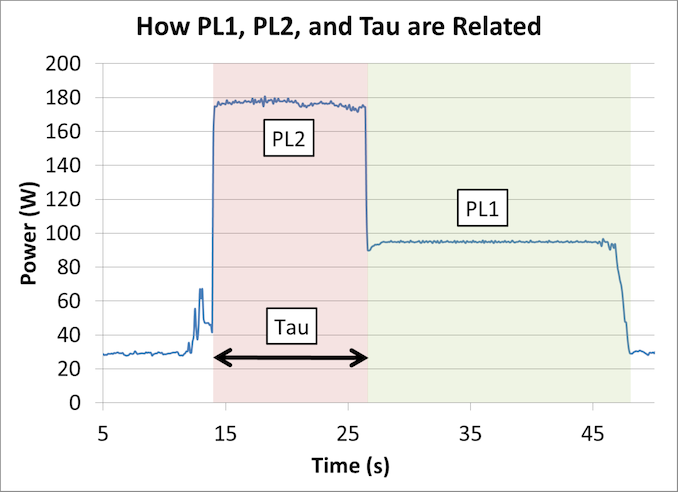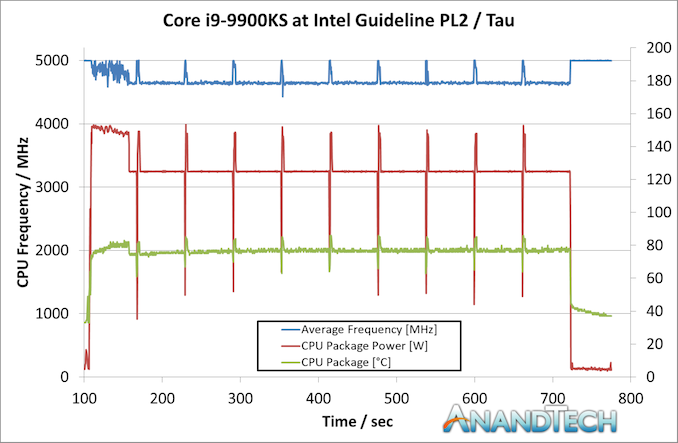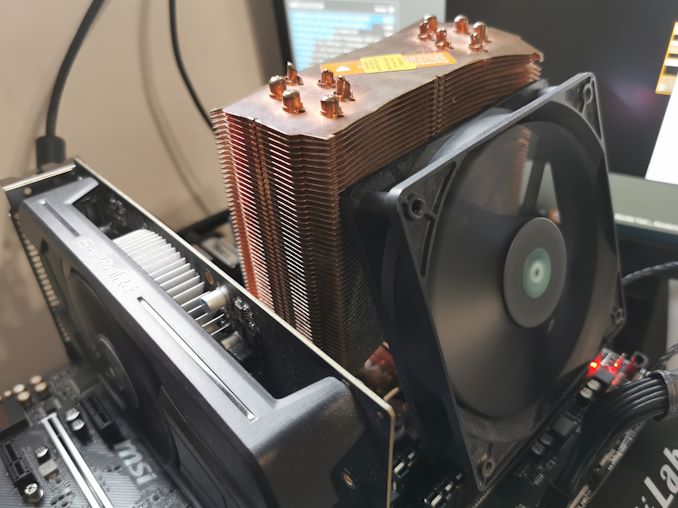The Intel Core i9-9900KS Review: The 5 GHz Consumer Special
by Dr. Ian Cutress on October 31, 2019 10:45 AM ESTGoing for Power
How to Manage 5.0 GHz Turbo
Intel lists the Core i9-9900KS processor as having a 127W TDP. As we’ve discussed at length [1,2] regarding what TDP means, as well as interviewing Intel Fellows about it, this means that the Core i9-9900KS is rated to require a cooling power of 127W when running at its base frequency, 4.0 GHz. Above this frequency, for example at its turbo frequency of 5.0 GHz, we are likely to see higher than 127W.
Now, I started saying in this review that the length of time that the processor will spend at 5.0 GHz will be motherboard dependent. This is true: Intel does not strictly define how long turbo should be enabled on any processor. It allows the motherboard manufacturer to ‘over-engineer’ the motherboard in order to help push the power behind the turbo higher and enable turbo for longer. The specific values that matter here are called PL2 (Power Limit 2, or peak turbo power limit), and Tau (a time for turbo).
For an Intel processor, each one has a ‘bucket’ of extra turbo energy. As the processor draws more power above its TDP (also called PL1), the bucket is drained to provide this energy. When the bucket is empty, the processor has to come back down to the PL1 power value, and eventually when the processor is less active below PL1, the bucket will refill. How big this bucket is depends on the value of PL1, PL2, and Tau. The bigger the bucket, the longer an Intel processor can hold its turbo frequency. Typically Tau isn’t so much as a time for turbo, but a scalar based on how big that bucket should be.

An example graph showing the effect of implementing Turbo on power/frequency
Motherboard manufacturers can set PL1, PL2, and Tau as they wish – they have to engineer the motherboard in order to cope with high numbers, but it means that every motherboard can have different long turbo performance. Intel even suggests testing processors on high-end and low-end motherboards to see the difference. Users can also manually adjust PL1, PL2, and Tau, based on the cooling they are providing.
For the Core i9-9900KS, Intel has given the PL1 value on the box, of 127 W. PL2 it says should at least be 1.25x the value of PL1, which is 159 W. Tau should be at least 28 seconds. This means, with a given workload (typically 95% equivalent of a power virus), the CPU should turbo up to 159 W for 28 seconds before coming back down to 127 W. A very important thing to note is that if the CPU needs more than 159 W to hit the 5.0 GHz turbo frequency, it will reduce the frequency until it hits 159 W. This might mean 4.8 GHz, or lower.
Despite giving us these numbers for PL1, PL2, and Tau, Intel also stated to us that they recommend that motherboard manufacturers determine the best values based on the hardware capabilities. The values of 127 W, 159 W, and 28 seconds are merely guidelines – most motherboards should be able to go beyond this, and Intel encourages its partners to adjust these values by default as required.
We tested Intel’s guidelines with a 10 minute run of Cinebench R20.
He we can see that at idle, the CPU sits at 5.0 GHz. But immediately when the workload comes on, it has to reduce the average CPU frequency because it goes straight up to the 159W limit – simply put, 159W isn’t enough to hit 5.0 GHz. We see the temperature slowly rise to 92C, but because the power isn’t enough the frequency keeps fluctuating.
By the end of the first Cinebench R20 section, it seems that the majority of it occurred during the turbo period. This means that this run scored almost the same as a pure 5.0 GHz run. However the subsequent runs were not as performant.
Because the turbo budget had been used up, the processor had to sit at 127 W, its PL1 value. At this power, the processor kept bouncing between 4.6 GHz and 4.7 GHz to find the balance. The temperatures in this mode kept stable, nearer 80C, but the performance of Cinebench R20 dropped around 8-10% because the CPU was now limited by its PL1/TDP value, as per Intel’s base configuration recommendation.
Going Beyond
Because motherboard manufactuers can do what they want with these values, we set the task on the motherboard we tested, the MSI Z390 Gaming Edge AC. By default, MSI has set the BIOS for the Core i9-9900KS with a simple equation. PL1 = PL2 = 255 W. When PL1 and PL2 are equal to each other, then Tau doesn’t matter. But what this setting does is state that MSI will allow the processor to consume as much power as it needs to up to 255 W. If it can hit 5.0 GHz before this value (hint, it does), then the user can turbo at 5.0 GHz forever. The only way that this processor will reduce in frequency is either at idle or due to thermal issues.
Here’s the same run but done with MSI’s own settings:
The processor stayed at a constant 5.0 GHz through the whole run. The CPU started pulling around 172W on average during the test, fluctuating a little bit based on exactly which 1s and 0s were going through. The CPU temperature is obviously higher, as we used the same cooling setup as before, and peaked at 92C, but the system was fully table the entire time.
Here was our system setup – a 2kg TRUE Copper air cooler powered by an average fan running at full speed in an open test bed.
But what this means is that users are going to have to be wary of exactly what settings the motherboard manufacturers are using. For those of you reading this review on the day it goes live, you’ll likely see more than a dozen other reviews testing this chip – each one is likely using a different motherboard, and each one might be using different PL2 and Tau values. What you’ve got here are the two extremes: Intel’s recommendation and MSI’s ‘going to the max’. Be prepared for a range of results. Where time has permitted, we’ve tested both extremes.













235 Comments
View All Comments
Dudler - Thursday, October 31, 2019 - link
P4 cough cough..Hifihedgehog - Friday, November 1, 2019 - link
*cough, cough* Emergency Edition *cough, cough*Man, whatever is going around is really catchy.
Spunjji - Friday, November 1, 2019 - link
It's vaguely amusing how they go for the same stock approaches every time. When a product becomes noncompetitive, either release a "special" bin that blows through acceptable power/stability limits, or ram a server CPU down the stack into "consumer" territory. The EE has a special place in my heart because they panicked so hard they did both of those things.Samus - Friday, November 1, 2019 - link
And much like the P4 EE, the power consumption is through the roof. Ahh the days of Presshot warming my dorm seeding a Napster queue.You really have to appreciate (again) what AMD is able to pull off here at 65w. It's literally on the heals of a CPU burning 3x more power.
Notmyusualid - Monday, November 4, 2019 - link
https://www.phoronix.com/scan.php?page=article&...Death666Angel - Saturday, November 2, 2019 - link
All true, but AMD does the same thing, as does Nvidia when it comes to GPUs. Remember the GTX 480? Or the FX-9590. :) If you mess up, that is mostly your only option to have something. Some people don't care much about efficiency and just want the fastest at a certain thing. They probably did the ROI numbers and it came out positive for them.Ratman6161 - Monday, November 4, 2019 - link
But...there are still quite a few tests where there is an orange bar at the top :). One thing I'm a bit curious about on the AMD side though is that there are several cases where the 3700X beats the 3900X. 3900X is both more cores and higher clocked so shouldn't it win everywhere?Also for those of us where price is an obejct, that 3700X looks pretty darn good against most everything else. :)
amnesia0287 - Friday, November 8, 2019 - link
It’s possible it’s related to the quality of the cores. With the Ryzen chips not all cores have the same limits. So in theory you could have a chip with less total cores but more higher spec’d ones.MDD1963 - Thursday, November 7, 2019 - link
Little need for any 'panic' as, gaming-wise at least, all AMD has managed is to tie the 8700K.....; everything 9700K and higher in the product stack remains virtually unopposed.WaltC - Monday, November 11, 2019 - link
I'm still trying to figure out how a higher clocked Intel CPU which processes data slower than a lower-clocked AMD cpu is a "clear advantage" for Intel....;) Perhaps Dr. Cutress might enlighten me...?....;)